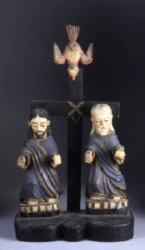The Blessed Trinity
Door-to-door missionaries such as the Jehovah’s Witnesses and Mormons attempt to convince any Catholic who will listen that the Catholic doctrine of the Trinity is wrong. They argue that the concept of one God in three co-equal, co-eternal, consubstantial persons is not biblical. The Bible, however, says otherwise.
It is clear that:
1) There is only one God: Deuteronomy 6:4; Mark 12:29; 1 Timothy 2:5;
2) The Father is God: Deuteronomy 32:6; Matthew 13:32, 25:34; Luke 11:2; 1 Corinthians 15:24; Ephesians 4:6;
3) The Son, Jesus Christ, is God: John 1:1-14; John 20:28; John 8:58 ff., Acts 20:28.
4) The Holy Spirit is God: John 14: 16-17, 26; John 16:7-14; Acts 5:3-4; Acts 13:2-4; Acts 21:10-11.
From these explicit truths, and under the guidance of the Holy Spirit, Who guides the Church “into all truth” (cf. Jn 14:25-26; 16:12-3), the Catholic Church teaches that if there is only one God, and the Father, Son, and Holy Spirit are each God, then the doctrine of the Trinity -- one God in three persons -- must also be true, or else the revelations that there is one God, and that Father, Son, and Spirit are each true God become a jumbled mass of irreconcilable contradictions. (An excellent book to read on this subject is Frank Sheed’s, ‘‘Theology for Beginners.’’) And though one will not find the word “Trinity” in Scripture, the above passages point us toward the doctrine of the Trinity, which God revealed gradually, indirectly, and in various ways (cf. Heb 10:1). The term “Trinity” was used by St. Theophilus of Antioch in the year A.D. 180. He wrote in his Epistle to Autolycus, a pagan critic of the Catholic Church, that God, his word, and his wisdom are a “Trinity” (Greek: triados).
Some years later, Tertullian (A.D. 160 -- circa 250) coined the Latin term for Trinity (trinitas) in his work ‘‘On Modesty.’’ He wrote about the “Trinity of the One Divinity; Father, Son, and Holy Spirit” (Chapter 22).
The early Church writers drew upon the many biblical references to God’s unity and transcendence as well as Old Testament episodes known as “theophanies” -- mysterious appearances of one or more persons of the Trinity.
Examples of theophanies and mysterious and sometimes implicit references to the three persons in the Trinity are Genesis 1:26, (where God speaks of himself in the plural form), Genesis 3:22, 11:27; Genesis 18 ; Psalm 2:7; Psalm 109:1-3; Isaiah 7:14 (Emmanuel is the name prophesied for the miraculously-conceived child of a virgin. It means “God is with us.”), Isaiah 9:6; Isaiah 11:2; and Isaiah 35:4. Other passages include Proverbs 8:22-31; Wisdom 7:22-28; Wisdom 8:3-8; Ezekiel 11:5; Ezekiel 36:27; Joel 2:28; and Malachi 3:1.
Two of the more explicitly Trinitarian passages are Matthew 28:18-19 and John 1:1-14. In the first passage, the Lord said: “All authority in heaven and on earth has been given to me. Go therefore and make disciples of all nations, baptizing them in the name of the Father and of the Son and of the Holy Spirit.” Notice that Christ uses the singular form “name,” not the plural “names,” when he gives this directive. This usage implies the unity of the three divine persons in the Trinity.
John 1:1-14 says, “In the beginning was the Word (Christ), and the Word was with God and the Word was God . . . And the Word became flesh and dwelt among us, full of grace and truth; we have beheld his glory, glory as of the only Son from the Father.” St. Paul echoed this theme that Christ is true God, the second person of the Trinity, when he wrote that he is “the image of the invisible God” (Col 1:15) and the “radiance of the glory of God and the very stamp of his nature” (Heb 1:3).
As the Catholic Church matured and grew, so did the theological vocabulary she used to speak about her doctrines. Terms such as “Trinity” were developed as a way to precisely express what the Church meant by “God.” And though the Church’s understanding of her teaching deepened and developed, she did not “invent” new doctrines. Rather, she inferred truths with certitude from other truths. Some of these truths, such as that there is only one God, are explicitly taught in the Bible as well as sacred tradition. Because, in the sense described above, doctrine “develops” in the Catholic Church (though it never changes or ceases to mean what it once did), the First Council of Nicaea (A.D. 325) authoritatively defined as dogma the doctrine of the Trinity.
These days, Jehovah’s Witnesses, Mormons, Oneness Pentecostals, and other religious groups try to convince people that the Catholic Church “invented” the doctrine of the Trinity



















